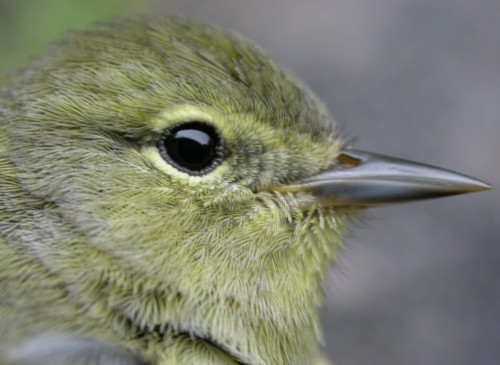|
McGILL BIRD OBSERVATORY |
|||||||||||||||||||||||||||||||||||||||||||||||||||||||||||||||||||||||
Welcome
to the McGill Bird Observatory weekly report.
Click here for a complete listing of our archives.
Banders-in-charge:
Marcel Gahbauer, Marie-Anne Hudson, Barbara Frei
Notes: It was an exceptional but peculiar week at MBO. In retrospect, complaining about the rain last week was somewhat premature, as it was this week that it really came down on us relentlessly. On Saturday we were rained out entirely, and every other morning except Tuesday we lost at least some hours to rain and/or wind. In total, over 85 mm of precipitation fell during the week, with at least 5 mm each day except Monday. It was also quite cool, with daily highs ranging between 10 and 16 degrees Celsius. As a result, it was rather dreary weather to be out in, and the flooding on site is almost back up to the record levels we were seeing at the end of the spring thaw. The amazing thing is that despite these conditions, we set several records this week. In spring 2005, we never recorded more than 64 species in a single day. This week we surpassed that mark four times, including three new records along the way - 66 on Tuesday, 72 on Thursday, and then 76 on Sunday! Included in Sunday's total were two species we've never had at MBO before - Brant, and White-winged Scoter, both flying north overhead. Sunday we also banded a wider variety and greater number of birds (37 individuals of 18 species) than any other day yet this spring, though those numbers are still lower than our spring 2005 records. Other observatories further south are only now beginning to record peak numbers of birds, so an influx may yet be on the way here in the next week or two. Perhaps the most impressive new record is the 104 species observed over the past week. This is by far the greatest diversity we've recorded at MBO in such a short period. Included in this were 20 warbler species, with as many as 16 of them being seen on a couple of the best days. Warblers accounted for several of the 19 new arrivals this week (Orange-crowned, Parula, Blackburnian, Bay-breasted, Wilson's, Common Yellowthroat). Among the others were Hooded Merganser, Chimney Swift, Veery, Red-eyed Vireo, Swainson's Thrush, Indigo Bunting, Scarlet Tanager, and Field Sparrow. The last few new migrants have already put us over last spring's season total of 134 species. The goose family featured last week was seen fairly regularly this week, going from end to end of Stoneycroft Pond, and even wandering up the path to the corn field near the gate. Meanwhile, we spotted the year's first brood of Wood Ducks on Sunday morning - ten little ones probably no more than a couple of days old, rushing after mom at the north end of Stoneycroft Pond. Among the banding highlights this week were Orange-crowned Warbler, Cape May Warbler, and Field Sparrow, none of which we've banded in spring before. Ten warbler species were banded, with some common species still missed so far, and hopefully yet to find the nets next week. Overall 13 species were banded for the first time this year. The Red-winged Blackbirds managed to hold on to the top spot for yet another week, but the next few spots are now occupied by warblers, and there are some new arrivals among the top ten, including Common Yellowthroat and Gray Catbird. Our 600th bird of the season was banded at the end of Monday morning (correction: 595, plus 5 from a counting error!).
With gull activity dropping off a bit this week, Red-winged Blackbirds moved up to top the list of species observed. Crows are also still high on the list, though except for a day when nearly 70 of them mobbed a Great Horned Owl, they have been quieter and scarcer than in recent weeks. While it was very much a week of warblers, only Yellow and Yellow-rumped were consistently seen in large enough numbers to put them in the top ten. Two weeks of spring migration left ... we are eager to see what further surprises still await us!
|



